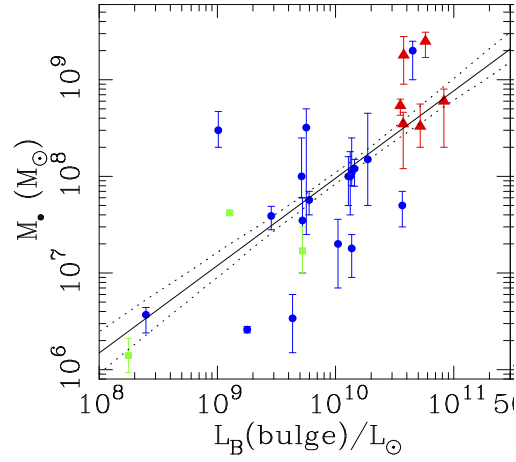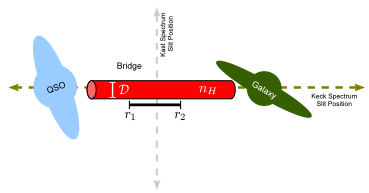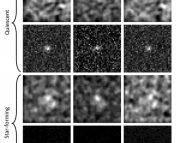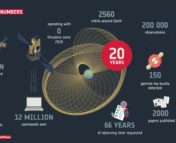Title: Solving the multi-messenger puzzle of the AGN-starburst composite galaxy NGC 1068
Authors: Björn Eichmann, Foteini Oikonomou, Silvia Salvatore, Ralf-Jürgen Dettmar, and Julia Becker Tjus
First Author’s Affiliations: (1) Institutt for fysikk, NTNU Trondheim, Norway; (2) Theoretische Physik IV, Facultät für Physik und Astronomie, Ruhr-Universität Bochum, Bochum, Germany; (3) Ruhr Astroparticle and Plasma Physics Center (RAPP Center), Bochum, Germany
Status: Published in the Astrophysical Journal (ApJ), open access
Pieces of the multi-messenger puzzle
Starburst galaxies have an extremely high rate of star formation (between 10-300 times the mass of our sun per year, while the Milky Way forms new stars at a rate of about 2 masses of the sun per year)1 and supernova explosions, making them an incredibly interesting source for astronomers studying the evolution of stars and galaxies. But they can also be intriguing multi-messenger sources, because of their emission of high energy gamma rays, indicating that these sources can accelerate particles up to extremely high energies.
When high energy particles (usually called cosmic rays) are accelerated to extreme energies, they can smash into each other, producing high energy gamma rays and neutrinos. These messengers (cosmic rays, photons, and neutrinos) can give us immense amounts of information about their sources.Today’s authors delve into the starburst galaxy NGC 1068, which also has an Active Galactic Nucleus (AGN) at its center, making it an interesting source for multi-messenger study. They describe their model for emission of gamma-rays and neutrinos from NGC 1068, and compare the model to observations from multiple telescopes (VLA, ALMA, Fermi-LAT, MAGIC, and IceCube).
What does a starburst galaxy look like?
Figure 1 shows a sketch of the structure of NGC 1068, including its AGN.
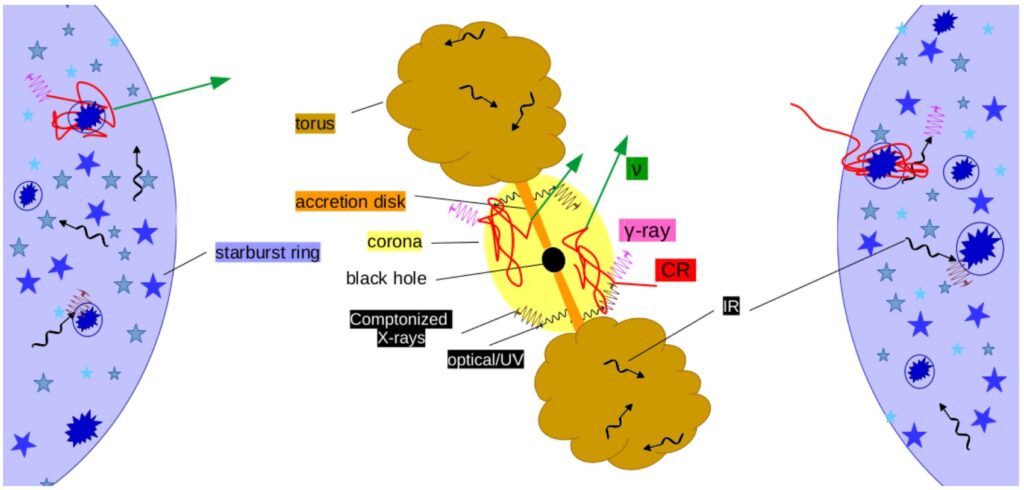
Starting from the center of the sketch, the supermassive black hole central to the AGN can be seen. An accretion disk surrounds the AGN, and this matter is being pulled inward towards the black hole (this is called accretion of the material, hence the name). Outside the plane of the accretion disk is the corona region of the AGN. Moving outward, there is a torus region of colder gas. Outside of the torus region is the starburst region, where the rest of the galaxy resides and orbits around the AGN.
Also on this sketch we can see the 3 different types of messengers that are being emitted by different regions. Cosmic rays (labeled CR) are shown in red, and can be seen to meander due to the presence of magnetic fields acting on these charged particles. Photons can be seen in sine-wave like lines, with the frequency indicated by the frequency of the sine wave. This paper focuses on the highest energy photons, gamma-rays, here labeled in pink, and other photons are labeled in black. However, NGC 1068 has also been observed with other frequencies of photons, so the authors incorporate radio and infrared data for NGC 1068 into the fit.
The green arrows represent neutrinos, which are being produced in cosmic ray interactions. Because neutrinos rarely interact, they travel away from the source virtually unimpeded.
So, what do we see when we look for gamma-rays and neutrinos from this source? The authors describe emission from two main zones of NGC 1068:
Zone 1: AGN Corona -> here, particles are accelerated by the AGN
Zone 2: Starburst region -> where nearby supernovae and star formation happens
Only by using both of these regions, not a model only for a single region as has been done in previous works, can these authors explain both the photon and neutrinos seen from NGC 1068.
What can this model say about NGC 1068?
After fitting their model using radio, infrared, gamma-ray and neutrino observations of NGC 1068, the authors plot the result of those fits and the total contributions in gamma-rays and neutrinos. This plot can be seen in Figure 2.
They show many individual processes that are fitted in the model to give the total expected emission in photons across a wide range of energies, from radio to gamma rays. The emission at the highest and lowest energies is expected by this model to come from the starburst region (blue solid line) while the middle energies come from the AGN corona (red solid line). In neutrinos, the model expectation falls near the observations from IceCube of NGC 1068, shown here in the green region, which appear to come from the AGN corona.
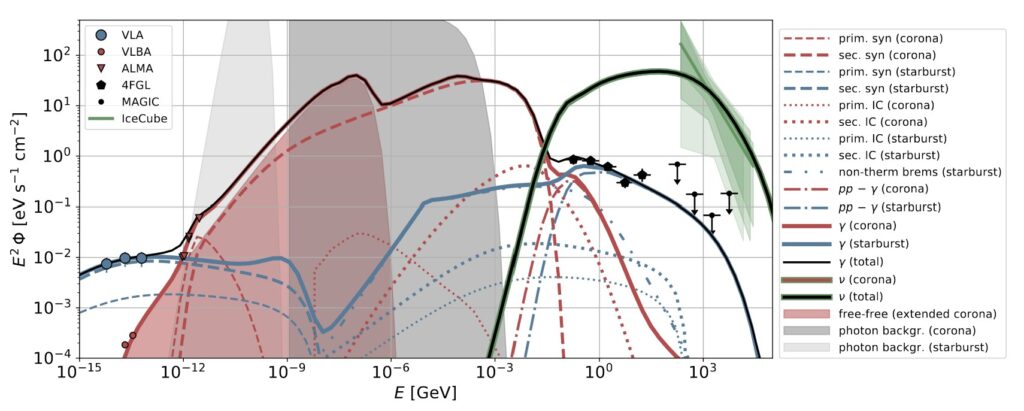
The model is able to explain all of the data across multiple wavelengths and messengers, with some small deviations. They see the gamma-ray emission at the highest energies (above 1 GeV) comes from the starburst region (Zone II), while the high-energy neutrinos (around 1 TeV) come from the AGN corona (Zone I). By using both zones in the model, all of the emission in both neutrinos and gamma-rays can be explained by this model.
This is the first multi-messenger fit including photons over a wide range of energies and neutrinos for an AGN-starburst composite galaxy. The entire model works well to explain all of the observed data seen in photons and neutrinos, making it an exciting evolution of astronomers’ understanding of NGC 1068, and other AGN-starburst composite galaxies.
1 Source: Schneider, Peter. Extragalactic Astronomy and Cosmology: An Introduction. Berlin, Heidelberg: Springer Berlin Heidelberg, 2015.
Disclaimer: The author of this Astrobite works with Julia Becker Tjus, but was not involved in this research.
Edited by: Pratik Gandhi
Featured Image Credit: Original image: NASA, ESA & A. van der Hoeven, Public domain, via Wikimedia Commons, edited

